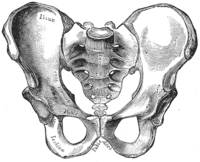
Photo from wikipedia
Introduction and hypothesis The aim of this study was to compare pelvic floor muscle strength (PFMS) and the prevalence of urinary incontinence (UI) and pelvic organ prolapse(POP) in women with… Click to show full abstract
Introduction and hypothesis The aim of this study was to compare pelvic floor muscle strength (PFMS) and the prevalence of urinary incontinence (UI) and pelvic organ prolapse(POP) in women with and without diastasis recti abdominis (DRA) at 6–8 weeks postpartum. Methods Three hundred and ten women underwent routine examinations, including POP quantification (POP-Q), PFMS measurement, DRA evaluation, and UI determination. Chi-squared tests and independent sample t test were used to compare the differences between women with DRA and without DRA. Results Women with DRA presented significantly lower prepregnancy body mass index (BMI), predelivery BMI, and postpartum BMI; greater gestational age; and higher birth weights than women without DRA( p < 0.05). Moreover, DRA incidence was significantly higher in those who underwent cesarean section (CS) than in those who underwent vaginal delivery (VD)( p = 0.045). Although the PFMS of the DRA group was weaker and the prevalence of UI and POP was slightly higher than those of the no DRA group, the results were not statistically significant. The PFMS of the CS group was stronger than that of the VD group. Urinary incontinence and prolapse incidence were higher in the VD group than in the CS group. Women who underwent CS had a shorter genital hiatus (Gh) and smaller Ba and Bp values than those in the VD group. Women without DRA had an increased chance of Bp ≥ −2 and Gh ≥ 3( p < 0.05). Conclusions Women with DRA were not more likely to have weakened PFMS and increased UI or POP at 6–8 weeks postpartum.
Journal Title: International Urogynecology Journal
Year Published: 2019
Link to full text (if available)
Share on Social Media: Sign Up to like & get
recommendations!